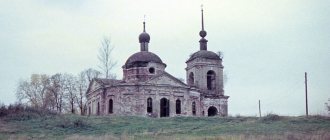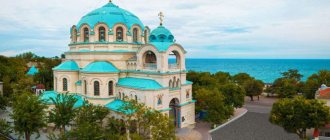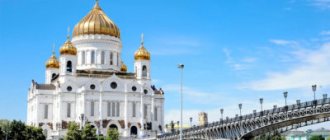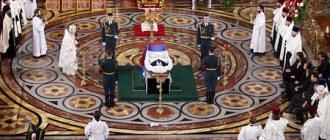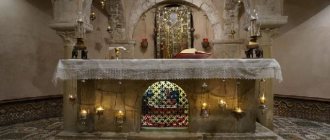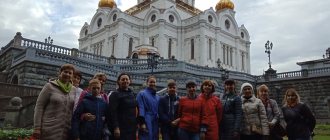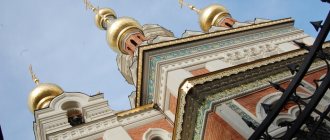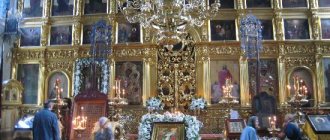The Orthodox tradition presupposes a very reverent attitude towards the relics of saints. People come from the most remote places of our country to venerate them, and people are ready to stand in line for many hours in order to be in the church and bring their request or prayer of gratitude to the shrine. This is exactly what happened when the relics of St. Nicholas the Wonderworker were brought to the Cathedral of Christ the Savior this summer (in 2021). Almost half a million Russians managed to see them. They came to Moscow from all cities of Russia and spent more than half a day waiting before they got to the temple. But none of the pilgrims complained, because each of them expected a miracle from the saint. And miracles require humility and faith, ministers of the Orthodox Church often repeat this.
The Cathedral of Christ the Savior, the relics of St. Nicholas the Wonderworker, were abandoned several months ago, but this incredibly important event is still talked about not only by believers, but also by politicians who were able to see in it the first step towards bringing the Orthodox and Catholic churches closer together. From our article you will learn everything about the stay of the holy relics of Nicholas the Wonderworker in the Cathedral of Christ the Savior, as well as about the saint himself and his lifetime deeds.
Location of the shrine
In the last month of spring of this year, with the help of Orthodox sponsors, the relics of St. Nicholas the Wonderworker were brought to Moscow to the Cathedral of Christ the Savior. Most people perceived this event with delight and hope for the reunification of the entire Christian world, which is now divided into Orthodox and Catholic.
The relics themselves are in permanent storage in the small town of Bari. They were brought there at the beginning of the nineteenth century and placed in a Catholic basilica. Negotiations about the visit of the shrine to our country began last winter. Then a meeting between Patriarch Kirill and Pope Francis took place in Cuba. Surprisingly, both church leaders quickly found a common language and were able to agree on key issues. For the first time in history, the shrine of the Catholic Church was transferred into the hands of Orthodox clergy. The entire Christian world perceived this gesture of goodwill as the first step towards bringing together all followers of one religion.
Excursions
The shrine is of interest to tourists. You can visit the attraction with a group or alone. The following excursions are popular:
- sightseeing tour of the temple with a visit to the observation deck
- everything about the temple (acquaintance with the history of the building, study of treasures and Orthodox shrines)
- temple and panorama of the capital (with a visit to the viewing platform)
- a story about miracles that took place around an Orthodox shrine
An interesting comprehensive tour. It involves visiting all Orthodox churches in the center of Moscow.
Description of the relics
Which relics of St. Nicholas the Wonderworker were brought to the Cathedral of Christ the Savior in Moscow with the help of sponsors? Pilgrims often asked this question when preparing to go to the shrine. Well, there's no secret to it. In May, the tenth left rib of St. Nicholas the Wonderworker was imported into Russia. It’s interesting, but the believers themselves believe that these particular relics have incredible power, because the rib was closest to the heart. And faith in God is born in him.
Return of a national shrine
If you have been to the Cathedral of Christ the Savior in Moscow, then, undoubtedly, you have noticed the icon “Our Lady Hodegetria” with the marks of the earthly life of the Mother of God, which stands in a place of honor to the right of the altar in a specially made cabinet and icon case under glass. The modest attire of the icon, in sharp contrast, emphasizes the deep spiritual power emanating from this bright image.
Today, few people know that back in the 16th century, the icon “Our Lady Hodegetria” was glorified as miraculous, and from the 17th century it gained all-Russian fame. This image is a copy of the Smolensk Icon of the Mother of God, revered in Rus', called “Hodegetria,” brought from Constantinople in 1046. It was painted by an outstanding representative of the Upper Volga icon painting school at the turn of the 15th-16th centuries for the Church of the Nativity of the Virgin Mary in Ustyuzhna.
Well-known researcher of the artistic culture of the Vologda land A.A. Rybakov found a mention of the miraculous icon in the church inventory of 1567: “The image of the miraculous most pure Odgetrie with her deed, local, on gold. And from that image God gives and the Most Pure Mother of God asks for healing for the sick and sick.”
In those distant times, Ustyuzhna was called Zheleznaya or Zhelezopolskaya and was famous for the mining and processing of iron. Since the 15th century, it has become a major center for the production of various weapons, the second most important in Russia after Tula. The intercession and happy deliverance of Ustyuzhna Zhelezopolskaya from the invasion of the troops of False Dmitry II in the Time of Troubles brought special glory to the Ustyuzhna Hodegetria. In April 1608, in a two-day battle near Bolkhov, the impostor defeated Shuisky’s army led by the Tsar’s brothers, Dmitry and Ivan, and in early June he approached Moscow, setting up a camp in Tushino (hence his nickname Tushino Thief).
S.M. describes in detail the events of that time. Soloviev in “History of Russia since ancient times.” He mentions the Ustyug icon “Our Lady Hodegetria” along with the Kazan icon of the Mother of God. In Moscow, and even more so in the regions, turmoil reigned. Taking advantage of this, the Tushins captured many cities: Velikiye Luki, Pskov, Suzdal, Uglich, Totma, Rostov, Pereyaslavl, Yaroslavl, Vladimir submitted to them.
At the end of 1608, the war reached Ustyuzhna, where at that time there was no governor. The Ustyug residents elected Andrei Petrovich Rtishchev, who came from Moscow, as governor. Then Foma Podshchipaev with 400 people came to their aid from Beloozero. Rtishchev and his army set out to meet the Poles and on January 5, 1609 met the enemy near the village of Bitnevka. According to a contemporary, “the people of Ustyug and Belozersk, having no idea about military affairs, were surrounded and cut down like grass.” The survivors decided: “It is better for us to die for the house of the Mother of God and for the Christian faith on Ustyuzhna.” Soon the Poles again went to Ustyuzhna; On February 3, the guards saw the enemy from the towers. The townspeople shouted: “Lord, have mercy!” started shooting back. The enemy retreated, but at noon again moved to attack and retreated again. At one o'clock in the morning the Poles launched a new attack, but the townspeople repelled it and took away the besiegers' cannon, and then drove them four miles from the city. However, on February 8, having received reinforcements, the Poles once again approached Ustyuzhna and were again repulsed, suffering heavy losses. They never returned. According to legend, it was in this battle that the city’s defenders were inspired by the icon “Our Lady Hodegetria,” which was specially taken from the temple.
Since then, every year on February 10, the residents of Ustyuzhna celebrated the salvation of their city from the enemy and made a religious procession, during which they carried the miraculous icon.
In 1691, on the site of the burnt wooden Church of the Nativity of the Virgin Mary, a new stone five-domed cathedral was erected, in which the craftsmen of the Moscow Armory built a five-tiered iconostasis. The image of “Our Lady Hodegetria” was given a place of honor in it. In 1821, through the efforts of parishioners, the icon was dressed in a silver gilded robe studded with precious stones. The crown alone was decorated with 366 diamonds, 16 emeralds, topaz and two amethysts.
The Cathedral of the Nativity of the Virgin Mary remained active until the mid-1930s. It was closed in 1936. The church community appealed the decision of the regional executive committee in court, but to no avail. The temple was transferred to the local history museum, and services stopped. The stone chapels on the southern side of the cathedral fence, built in the name of St. Nicholas in memory of the salvation of Emperor Alexander III and his family, were turned into stalls for the sale of water and beer; the heavily looted altar and church utensils became museum exhibits. Thus, the icon “Theotokos Hodegetria,” deprived of its decoration, was “excommunicated from the Church,” but the difficult trials that befell it did not end there.
On the night of May 23, 1994, three unknown people entered the temple gatehouse. The watchman and his friend were drinking vodka, and before both of them had time to utter a word, they were injected with sleeping pills. When they woke up, they did not find the seven most valuable icons in their usual places. The theft from the Ustyuzhensky Museum of Local Lore still remains unsolved and is the largest and most daring in the criminal history of the Vologda region. The total value of the stolen, now state property, was $2 million, the most expensive was the icon of Our Lady Hodegetria. According to the most conservative estimates, her insurance estimate was at least $500 thousand.
Presumably, the criminals took the icon out of the area in a van, having previously divided it into three parts. Subsequently, Hodegetria ended up in Finland, and then in Germany, disappearing for 11 long years.
And in June 2005, an image of the icon “Our Lady Hodegetria of Smolensk” appeared on the website of the London Richard Temple Gallery. The link stated that it had already been sold to Belgium, and was present in the gallery as an exhibit for temporary storage. The icon was identified by one of the London specialists in ancient Russian painting, as well as by police officers, as stolen in 1994 from the Ustyuzhna Museum in the Vologda Region.
Information received from the UK National Central Bureau of Interpol reported that the gallery owner purchased the icon approximately two years ago for 60 thousand pounds from a collector from Germany (a former citizen of the USSR), who owned it for more than five years. Mr Temple later sold the icon for £170,000 to a Brussels collector, but asked to rent it in order to display it in his gallery.
The case of the theft from the local history museum had been under investigation by the Ustyuzhensky District Department of Internal Affairs of the Vologda Region since May 1994, and by the time the icon was discovered it had been discontinued due to the expiration of the statute of limitations for criminal prosecution. It turned out to be impossible to reclaim it on the basis of an international investigative order.
Having made sure that the icon exhibited in London is a valuable monument of Russian culture, Rosokhrankultura employees entered into negotiations with the owner of the gallery within the framework of private international law in accordance with the authority of the service to restore the legal property rights of the Russian Federation.
I was lucky enough to deal with all the organizational and legal issues of returning the icon to Russia. Having previously arranged a meeting, I flew to London. It turned out that Richard Temple has been collecting icons for more than 40 years, and his gallery is known in many countries. He had no doubts about the return of the icon. Having received official materials confirming Russian ownership, Temple, despite the costs incurred, including restoration, returned the icon free of charge, renouncing his rights as a bona fide purchaser.
Having completed the necessary export documents and carefully packed the priceless cargo at the Christie's auction house, I flew to Moscow. The next day after arrival, the expert council of Rosokhrankultura was assembled. Having carefully examined the icon, experts confirmed its authenticity, noted the satisfactory condition of the paint layer and the presence of individual renovations made after the 1968 restoration at the Voronezh Special Scientific Restoration Production Workshop (VSNRPM). There were no museum inventory numbers on the icon - they were destroyed by robbers.
The question immediately arose about the further storage of the monument. It must be said that previously the Department for the Preservation of Cultural Property of the Russian Ministry of Culture had already returned to the Ustyug Museum one of the seven stolen icons - “Saints Boris and Gleb” from the late 15th century, discovered in 2000 in Germany. However, I made a different proposal regarding Hodegetria. The fact is that the Smolensk image of the Mother of God Hodegetria, symbolizing the unity of the people in hard times and being an all-Russian shrine, became the forerunner of the formation of Russian statehood. After 70 years of “excommunication from the Church” and 11 years of wandering far from the homeland, the rediscovery of the shrine by our state and Orthodox believers seemed possible only through the Church.
Taking all the circumstances into account, Rosokhrankultura, in agreement with the Russian Ministry of Culture, decided to return the icon to the Church. On January 22, 2006, in the Patriarchal Chambers of the Kremlin, President of the Russian Federation V.V. Putin handed over the miraculous Ustyuzhensk Icon of the Mother of God to His Holiness Patriarch Alexy II of Moscow and All Rus'. On February 19, 2006, on the Sunday of the Prodigal Son, Alexy II celebrated the Divine Liturgy in the Cathedral of Christ the Savior. Before the start of the service, the miraculous Ustyuzhensky copy of the Smolensk Icon of the Mother of God, returned to Russia, was brought to the temple. His Holiness the Patriarch met the shrine and, congratulating everyone on the triumph of its return, in particular, said: “The name of this image “Hodegetria” is translated from Greek as “Guide”, and we now see that in a providential way this wonderful icon traveled through foreign cities and countries directed her path to her place of residence, overcoming many different temptations along the way... May the Lord, through the prayers of our Most Holy Lady Theotokos, protect us from temptations in the sea of everyday troubles, and may the Most Pure Mother of the Savior herself become Hodegetria for each of us.”
The author expresses gratitude to L.I. Lifshits for the examination and attribution of the icon.
Photo: V.A. Sklyarov, A.I. Ganyushin
A few words about the saint
Nikolai Ugodnik is revered by believers all over the world. People come to him with various problems and requests. It is believed that during his lifetime the saint was so kind that he helped everyone who needed it. Naturally, even after death he continues to listen to the prayers of believers and guide them on the true path.
It is known that Saint Nicholas lived around the fourth century AD. His parents waited a very long time for the Lord to send them a child, and constantly prayed about it. At the end of their lives, God heeded their requests, and an extraordinary boy was born. Surprisingly, almost immediately after his birth he began to work miracles. For example, during baptism, the baby stood up on his feet and stood in this position throughout the entire ceremony.
Nicholas devoted all his time to the Holy Scriptures. He was so religious and pious that he practically did not leave the walls of his house so as not to spend time in idleness. Very soon they began to turn to him for advice, and the boy never refused it to anyone who asked.
The boy's uncle, seeing his nephew's religious zeal, advised him to give him up to serve God, which was done. Young Nicholas very quickly received the rank of priest, and then became the bishop of the city of Myra. Some descriptions of the saint’s life indicate the fact that, thanks to a heavenly sign, the clergy immediately elevated the young man to the position of bishop. Historians do not dispute this version, because in those distant times this was quite possible.
Nikolai Ugodnik devoted his entire life to serving God and people. He was and is considered an intercessor for souls before the Creator, and prayers to him carry enormous power.
Architecture and interiors
Anyone who has seen the building will say that it is original. This is natural: architects did not just draw sketches and then prepare drawings. In their projects they embodied the ideas that they saw in the victory over Napoleon. A victory that was won not only by Russian weapons, but by the entire people.
The original temple
The creator of the original project, Witberg, was a Freemason. But the ideas of the mason brothers did not distort the image he created. Vitberg believed that the temple should be triune and consist of three connected and complementary parts:
- Underground, shaped like a coffin. This part is dedicated to the Nativity of Christ. Constant funeral services for fallen heroes were to be held here.
- Ground. This part is dedicated to the Transfiguration of the Lord and had a cruciform shape. This symbolically reflects the mixture of light and darkness in the human soul. This part was supposed to have a lot of statues.
- The top one, dedicated to the Nativity of Christ. It should have been round.
The temple was supposed to face the Moscow River. Thon's project also assumed a similar arrangement. But the scale was completely different. In those days, the tallest building was the bell tower of Ivan the Great. Contemporaries noted that the entire thing could have entered the cathedral under construction.
Ton managed to organically fit the temple into the ensemble of the Kremlin and Moscow churches. This became possible due to the favorable location of the building. The building was located at a distance from the Kremlin, but at the same time harmoniously combined with it.
The characteristic features of the temple of that period are:
- keel-shaped zakomari
- onion-shaped heads
- covered gallery running along the entire perimeter
These elements were borrowed from churches built by Russian architects in the 15th and 16th centuries. In the project, Ton moved away from the classics and gave preference to folk traditions. The architect managed to successfully combine elements of ancient Russian architecture and Byzantium. The author thereby showed the continuity of forms and at the same time new fashion trends.
- 23 best Moscow museums for children
- 30 best things to do in Moscow for kids
- 20 best parks in Moscow for families with children
Modern temple
The modern building was erected on a powerful stylobate. The construction of this part was required in order to restore the hill on which the original cathedral was located. The natural elevation was destroyed after an explosion in the 1930s.
Actually, the cathedral is a complex of several buildings that are connected by an architectural design:
- Church of the Transfiguration
- tent chapel of the icon of the Mother of God
- the temple itself
The Church of the Transfiguration of the Lord is located in the stylobate part. There are also office premises, a museum, refectories, halls of Councils and Cathedrals. A cathedral was erected above the stylobate. The chapel is a separate building. The building has 4 porches. To climb them, you will have to overcome 15 steps. The porches are lined with dark red granite. For lighting, lamps are installed on the upper platforms.
The interior is well illuminated by daylight. For this purpose, 60 windows are provided. The facade is decorated with kokoshnik arches. They are supported by 36 columns. The architectural lighting of the building deserves a separate description. Powerful lanterns send rays of soft, daylight-like light onto the façade. The domes are illuminated by lamps mounted on masts each 30 m long.
Miracles of St. Nicholas
During his lifetime, the saint committed many deeds that spread rumors about him throughout the world. First of all, he is considered the protector of sailors and travelers. This is due to the fact that in the biography of Nikolai Ugodnik there are many stories about his rescue of sailors. One day he resurrected a sailor who had fallen to his death from a mast. Another time, the saint did not allow a traveler to board the ship, seeing that he would die during a storm. Nicholas is also credited with numerous cases of pacifying the elements.
Often it is this saint that young unmarried girls who dream of starting a family pray to. Nicholas is considered the patron saint of girls, because during his lifetime he saved three sisters who did not have a dowry from shame. They were raised by one father, who was very sad that his daughters would have to earn a living with their appearance. After all, without a dowry, no one will ever marry them. Hearing his speech, Nikolai threw a bag of money onto his porch. This allowed the happy father to marry off the eldest of his daughters. When the middle one grew up, a bag of gold appeared on the man’s porch again. And she quickly found herself a husband. When the time came for the third sister to get married, her father began to watch at night for the benefactor who was helping their family. One night, he saw Nikolai leaving money on the doorstep. But he asked the man not to reveal his secret to others.
In addition to the benefits already listed, the saint became famous for treating the sick, protecting orphans and the oppressed, and caring for those who were unjustly condemned or accused.
How did the shrine end up in Italy?
As we said, the relics were brought to the Cathedral of Christ the Savior on a special flight from Italy. However, they got there as a result of abduction, because after death the saint’s body remained in the World.
According to historical sources, literally immediately after his death, pilgrims flocked to the body of Nicholas the Pleasant. Over time, a small basilica was erected over his grave, which was later transformed into the Church of St. Nicholas.
In the eighth century AD, the Turks, who invaded many territories, began plundering Christian shrines. During this period, many of them were destroyed and lost, so Christians feared for the fate of the relics of St. Nicholas the Pleasant. However, it was not the Turks who stole them from the church.
The city of Bari was once famous throughout Italy as a religious center, but it managed to lose its significance. The city's residents set out to regain glory by hosting the saint's relics. Therefore, an expedition went to Mira, the purpose of which was the banal theft of the ark. The same goal was pursued by Venetian merchants, who dreamed of bringing the shrine to their city. The most successful were the Barians, who at the end of April 1087 entered the church, broke the sarcophagus and took out the relics of the saint from the ark.
Thus, most of the relics found their home in Bari, where they are kept to this day. However, small parts of the skeleton were stolen by the Venetians. Later they were transported to Lido Island and a temple was erected there.
When the relics of Nicholas the Wonderworker arrived at the Cathedral of Christ the Savior: date
All the media talked about this event. After all, for the first time, a shrine was brought into Russian territory, the equivalent of which is difficult to find in the world today. The relics arrived at the Cathedral of Christ the Savior directly from the airport on May 21, 2021. They became available to pilgrims literally the next day. Many were interested, getting ready to go to Moscow, until what date the relics of St. Nicholas the Wonderworker would remain in the capital, because hundreds of thousands of pilgrims from almost all Russian cities wanted to go to the temple.
It is noteworthy that the shrine stayed in the capital for fifty-two days. Then she was taken on a special flight to St. Petersburg, where she remained until July twenty-eighth. After this, the relics safely returned to the Italian city.
Hall of Church Councils
This is one of the most famous and significant halls for holding such events. It opened in 2008 and is part of the restored Cathedral of Christ the Savior. The hall can accommodate up to 1250 visitors. It is decorated with frescoes and mosaic panels, the ceiling is a starry sky, and in the center there is a composition showing the descent of the Holy Spirit on the apostles - an important event described in the New Testament. On both sides of it there are mosaics depicting two cities - the “Heavenly City” and the “Earthly City”. The four round columns are decorated with portraits of famous people of the Russian Land - saints, statesmen, warriors of the Lord. In addition to luxurious interior decoration, the hall is distinguished by comfortable chairs and excellent technical equipment. An unusual arrangement, in which the auditorium is not separated from the foyer, creates special acoustics and pleasant coolness. In the foyer, a favorite corner of the guests, there is a winter garden full of flowers and wonderful plants, small waterfalls and sculptures depicting fantastic animals.
All kinds of cultural programs are regularly held in the Hall of Church Councils - concerts of church choirs and sacred music, children's parties, festivals, meetings and conferences. It is better to arrive early for events to avoid queues at the entrance and in the cloakroom.
© Alexey Kleptsov
Sponsorship
Believers do not always think about how difficult it is to organize a visit to religious shrines in another country. It is quite expensive, so it is impossible to meet the budget without the participation of sponsors. However, there are still people in the country who are not indifferent to spiritual development, and they are ready to spend in order to gain it later.
It is known that the main sponsor of the journey of the relics to the Cathedral of Christ the Savior is a large Russian chemical concern. took upon itself all the main expenses for transportation, support and protection of the shrine on the territory of our country. Additional funding was provided by the capital's government.
It is noteworthy that PhosAgro is known not only for bringing the relics of St. Nicholas the Wonderworker to the Cathedral of Christ the Savior, but also for organizing Sunday schools, creating websites where you can get information on Orthodox topics, and promoting any events that lead to the spiritual enrichment of people.
Therefore, we can hope that in the future our country will be visited by more than one shrine brought from Orthodox or Catholic churches scattered throughout the world.
Church opening hours
Visiting the relics of St. Nicholas the Wonderworker in the Cathedral of Christ the Savior was available from eight in the morning. It was at this hour that its doors opened to believers thirsting for spiritual food. People had to leave the temple by nine o'clock in the evening. However, due to the huge number of believers wanting to get closer to the shrine, the opening hours have been extended. Often the temple closed after midnight. Unfortunately, this time was not enough for the pilgrims. Many even tried to stay in line at the relics of St. Nicholas the Wonderworker all night so that they could still be the first to enter the temple in the morning.
Story
The first attempts to build the Cathedral of Christ the Savior were made under Emperor Alexander I century. honor of Russia's victory over Napoleon's army. Nicholas I, who replaced Alexander I on the throne, in 1832 invited another architect to work on the temple - Konstantin Ton, who studied and applied the traditions of ancient Russian architecture. They decided to build the temple on the site of the former Alekseevsky Convent, from where it would be visible from anywhere in Moscow, and besides, the proximity to the Kremlin would emphasize the deep connection of the Cathedral of Christ the Savior with Russian history and culture. The temple was built over almost 40 years: from 1839 to 1883.
© Julia Alisova
Finally, on May 26, 1883, it was consecrated in the presence of Alexander III and the imperial family. The capacity of the temple was up to 7200 people. The facades of the temple were decorated with marble high reliefs by sculptors Ivanov, Loginovsky and Ramazanov, the entrance doors of the cathedral were made of bronze, the interior of the cathedral was decorated with paintings and stone decoration (labradorite, porphyry, marble). Famous Russian artists worked on the decoration of the temple: V. Vereshchagin, V. Surikov, I. Kramskoy and other prominent representatives of the academic school of painting.
The building was surrounded by a gallery, which became the first museum of the War of 1812: on its walls there were marble plaques with chronicles of the Patriotic War.
The Cathedral of Christ the Savior existed for 48 years.
The decision of the Soviet government in 1931 was to destroy the temple and expand the nearby territory for the needs of the state. Instead of the Cathedral of Christ the Savior, it was planned to erect the Palace of the Soviets - a utopian project for the tallest building in the world with a rotating monument to V.I. Lenin on the roof. However, demolishing the Cathedral of Christ the Savior was not so easy: only two explosions could finally destroy it.
The surviving elements of the white stone decor after the explosion were built into the wall of the Donskoy Monastery.
Having collected groundwater, the builders completed the foundation of the Palace of the Soviets and began erecting the frame, but the shortage of building materials during the Great Patriotic War adjusted the plans. The foundation of the building was used for the construction of the year-round swimming pool "Moscow", which became one of the largest open-air swimming pools in the world. Despite the mixed reaction from the public, the pool was unique in terms of engineering design and existed from 1960 to 1994, and was closed only due to economic difficulties in the country.
© Yaroslav Glukhov
The idea of restoring the Cathedral of Christ the Savior on its historical site arose back in the 1980s. Restorers were involved in working on the project, but the final version of the external decor of the temple belongs to Zurab Tsereteli, who made the bronze medallions for the kokoshniks.
Construction and finishing work were symbolically completed by 2000 - the onset of the new millennium. Today the temple is the largest in Russia, it can accommodate 10,000 people.
In 2000, the royal family was canonized in the Cathedral of Christ the Savior.
How could you get into the temple?
Literally from the first day, incredibly long lines began to form on the way to the church. One could get to the relics of St. Nicholas the Wonderworker by standing outside for almost a whole working day. But over time, the number of believers only increased, so the wait stretched for twelve to thirteen hours. Not everyone could withstand this, because sick people thirsting for healing also came to the shrine. Some of them became ill and were forced to give up visiting the temple.
Usually the queue began at the Crimean Bridge, and only after passing all three checkpoints could one touch the treasured ark with the relics.
Feedback on the level of organization of visiting the temple
It is very important for ordinary believers that the Moscow government perfectly organized and coordinated all the actions of Orthodox believers, providing them with the most comfortable conditions in this difficult situation. Almost all pilgrims note the large number of volunteers and law enforcement officers all the way to the Cathedral of Christ the Savior to the relics of St. Nicholas the Wonderworker. Reviews from believers contain gratitude to these people who did their job very well. Without them, many would not have been able to stand in line for so long.
Despite the fact that recommendations were issued to Orthodox Christians going to the temple, which contained information about things that must be taken with them on the trip, the city government organized eleven food stations. They were painted a bright yellow-orange color, so it was quite difficult not to notice them. Here everyone could buy a full lunch or just have a snack. At the same time, many noted the affordability of prices. For example, a lunch of two courses and a drink cost pilgrims approximately one hundred and fifty rubles.
There were buses for rest along the entire route to the temple. You could sit and warm up in them for free.
Naturally, the organizers also took care of dry closets; they were installed in large numbers along the queue route. In case of deterioration of their health, pilgrims had to immediately contact volunteers or police. They radioed for doctors, and within a few minutes the person received the necessary help.
Observation deck
The viewing platform is located at an altitude of 40 m. This is a great way to view Moscow from an unexpected point. Entrance here is paid, and you have to climb on foot. (Sometimes tourists manage to take the service elevator. How lucky.) But the efforts spent will be more than rewarded with an amazing panorama.
There are vending machines on the staircase landings. They sell coins with the image of the cathedral. Buying souvenirs will brighten up a boring climb. The site encircles the perimeter of the building. The area is protected from precipitation and bright sun. Moving around the site, you can view the capital from different angles. There are surveillance cameras everywhere, the railings are quite high, and there are additional fences. Therefore, looking around the city is not at all scary.
Photo and video shooting is allowed on the viewing platform. In some places, binoculars are installed for ease of observation. In order to use them, you will have to pay. Time spent on the observation deck is limited. It is half an hour.
It is important to remember: since the entrance to the site goes through the temple, you will have to comply with a certain dress code.
The most powerful prayer at the relics of St. Nicholas the Wonderworker in the Cathedral of Christ the Savior
We have already mentioned that you can pray to this saint in a variety of situations. The Internet is replete with testimonies of people whom he helped cope with problems. Some stories truly resemble miracles. Therefore, believers are interested in which of the prayers to the saint is considered the most powerful. Let's try to find out.
I would like to note that quite a lot of prayers to the saint are known in Orthodoxy and we cannot list them all in one article. However, if we consider that people mainly came to the relics to ask for healing, marriage and help with money, we decided to give the texts of these three prayers.
They pray to the saint for healing quite often. Sometimes requests are expressed in simple and sincere words, but it is better to say a prayer specifically for healing. We will give its text below.
You can ask Nikolai Ugodnik about marriage in the following words.
Many pilgrims wanted to touch the shrine to ask for an improvement in their financial situation. Therefore, we could not help but mention this prayer:
If in spring and autumn you were unable to get to the Cathedral of Christ the Savior and venerate the relics of St. Nicholas the Wonderworker, then do not be upset. Another twenty-five churches in the capital contain fragments of the saint’s relics, where you can pray. Rest assured, the Pleasant will definitely hear your prayers and answer them.

